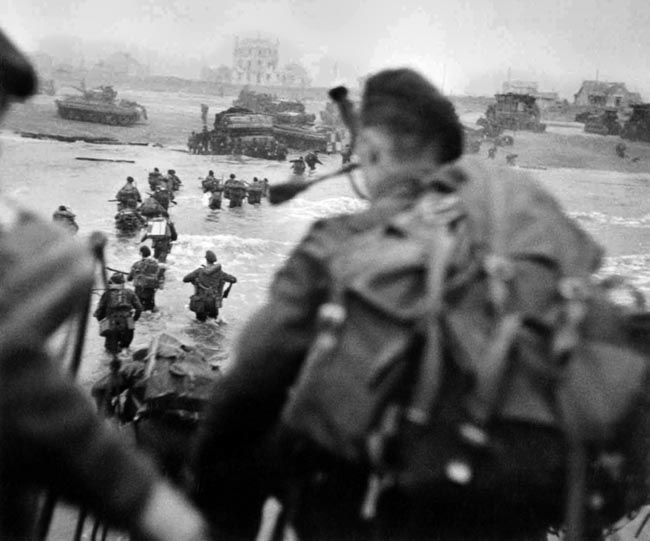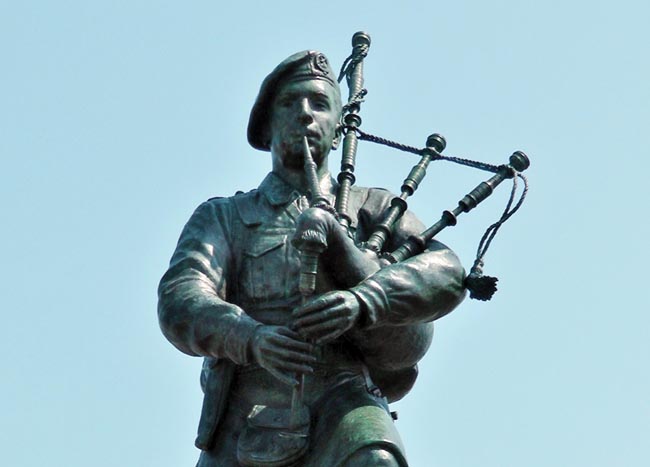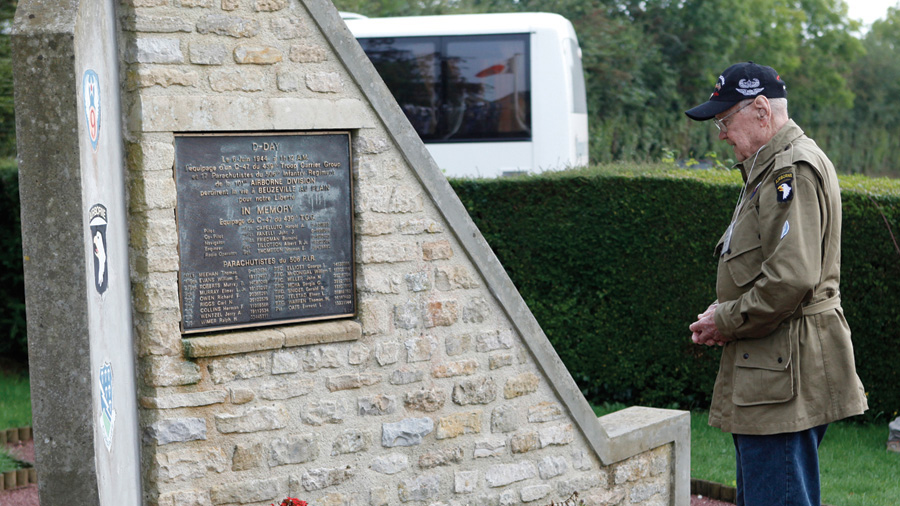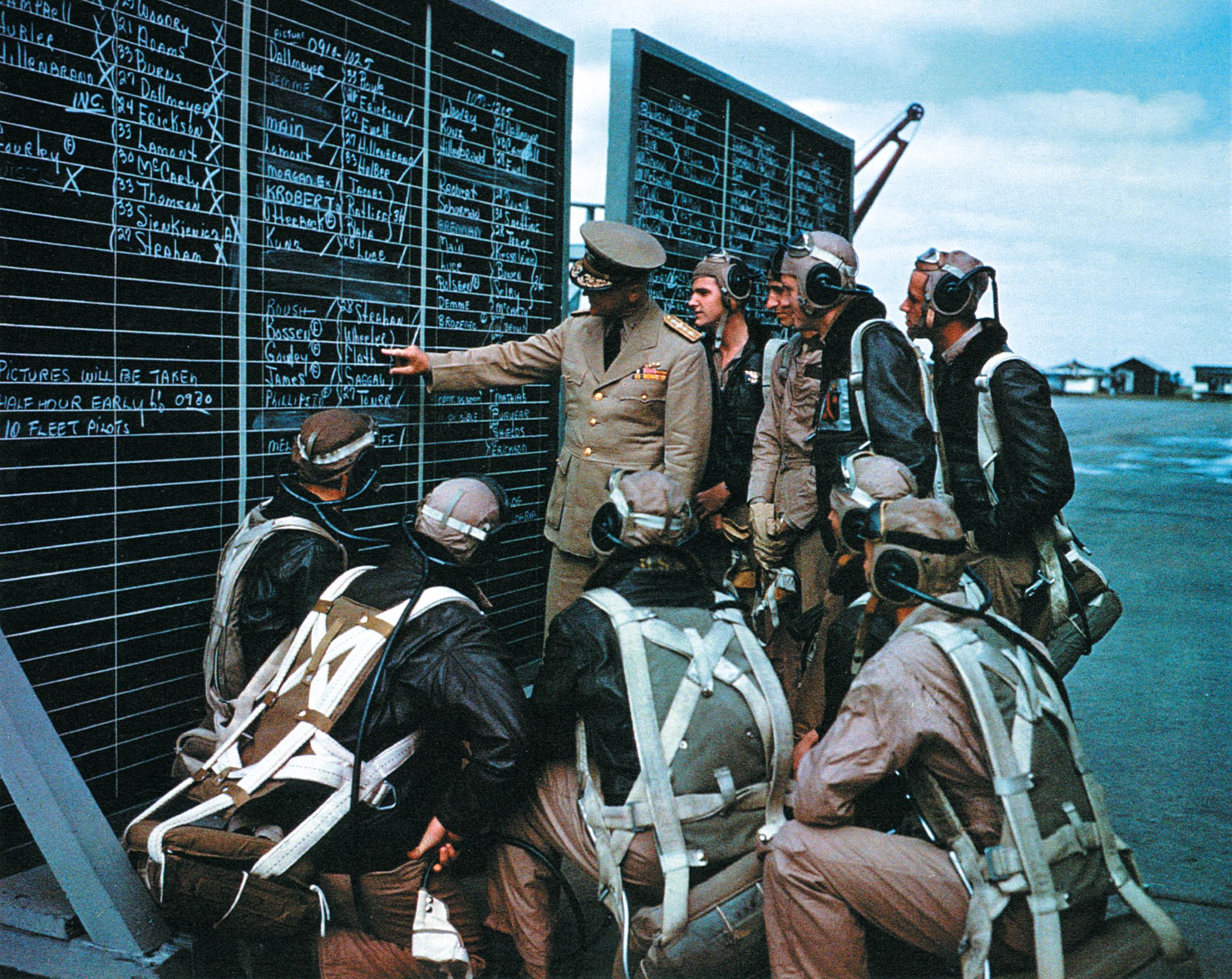By Michael D. Hull
It was the evening of Monday, June 5, 1944, and an armada of almost 5,000 ships stood off the southern coast of England, primed and ready for the greatest amphibious invasion in history. The long-awaited liberation of Nazi-occupied Europe by the British, American, and Canadian Armies was starting. To observers in the ports and coastal hamlets of Hampshire, Dorset, Sussex, and Devon, the great fleet of battleships, cruisers, destroyers, monitors, minesweepers, landing ships, and assault craft seemed to stretch to the horizon before heading toward its assembly area—dubbed “Piccadilly Circus,” south of the Isle of Wight—and then the Normandy coast. At one of many embarkation docks, Warsash, at the mouth of the River Hamble in Hampshire, Commandos of the crack 2,500-strong British 1st Special Service Brigade clambered aboard 22 landing craft that would take them across the English Channel to Normandy. One of the soldiers was boyish-looking, unassuming William “Bill” Millin of the Cameron Highlanders, the personal bagpiper of Simon Fraser, 15th Lord Lovat, the brigade’s handsome, charismatic commander.
Wearing a battledress tunic and the kilt of the Clan Cameron, Millin stood on the bow, took his pipes out of their box, and started playing the old Scottish air “Road to the Isles” as the landing craft steamed out of the Solent, between Hampshire and the Isle of Wight, and into the Channel. A sailor relayed the music over the ship’s loudhailer, and the sound carried across the water. Sailors and troops on other landing ships—tense and fearful of what they would face in a few hours’ time—cheered and threw their helmets into the air. Nearby warships joined the impromptu refrain. Two Royal Navy Hunt-class destroyers played “A-Hunting We Will Go” over their loudhailers, and Free French destroyers responded with the “Marseillaise.”
The only bagpiper and the only kilted soldier in the powerful Allied armada, 21-year-old Bill Millin was to become a singular figure in D-Day lore.
How Bill Millin Met Lord Lovat
He was born in Glasgow on July 14, 1922, the son of a policeman. The family moved to Canada and lived there for a few years before returning to Scotland. Young Bill attended schools in Glasgow. Before the outbreak of World War II early in September 1939, the young man enlisted in the Territorial Army (National Guard) and joined the 7th Battalion pipe band of the proud Highland Light Infantry. After being transferred to the Cameron Highlanders, he volunteered in 1941 for the newly formed British Commandos.

Bill Millin met Lord Lovat while undergoing rigorous combat training at Achnacarry, the Commando depot north of Fort William in the rugged northwestern Scottish Highlands. Lovat, the 24th hereditary chief of the Clan Fraser, also had joined the Commandos in 1941. After ranching in South America and attending Magdalen College, Oxford, he had enlisted in the famed Scots Guards and soldiered in Egypt before the war. He would become one of the legendary figures of World War II, distinguishing himself in Commando raids on the German-held Norway coast in December 1941 and during the ill-fated British-Canadian raid on the fortified French port of Dieppe on August 18-19, 1942. British Prime Minister Winston Churchill called Lovat “the handsomest man who ever cut a throat.”
At Achnacarry, Lovat invited Millin to become his batman. The young soldier turned down the offer, and Lovat agreed instead to take him on as his personal piper. The War Office had banned bagpipers from leading troops into action after the great losses on the Western Front in World War I, but Lovat, descended from a long line of Scottish warriors, had a mind of his own. “Ah, but that’s the English War Office,” he told Millin with a sly twinkle. “You and I are both Scottish, and that doesn’t apply.”
Early on the gray, windy morning of Tuesday, June 6, 1944, the Allied armada stood off the Normandy coast after butting through the choppy English Channel. It was a rough, wet crossing for the troops aboard the landing ships and assault boats, and most of them were so seasick that they could not wait to get ashore, no matter what dangers awaited them. Piper Millin was no exception. “I didn’t care what was going on ashore,” he reported. “I just wanted to get off that bloody landing craft.”
Preparing for the Assault on Normandy
The assault force comprising armored and infantry elements of the U.S. First and British Second Armies neared five landing beaches: two American, two British, and one Canadian. At the western end, Utah Beach was the objective of the 12th, 22nd, and 8th Regiments of Maj. Gen. Raymond O. “Tubby” Barton’s U.S. 4th Infantry (Ivy) Division, while Omaha Beach was the objective of the 115th and 116th Regiments of the U.S. 1st Infantry (Big Red One) Division led by Maj. Gen. Clarence R. Huebner. Farther east, brigades and Royal Marine Commandos of Maj. Gen. Douglas A.H. Graham’s British 50th (Northumbrian) Infantry Division made for Gold Beach, and brigades, Royal Marine Commandos and the 4th Special Service Brigade of the Canadian 3rd Infantry Division, led by Maj. Gen. Rodney F.L. Keller, approached Juno Beach. At the easternmost section of the assault area, Sword Beach was the objective of Maj. Gen. Thomas G. Rennie’s British 3rd Infantry Division, comprising the 27th Armored Brigade, several infantry brigades, British Commandos, Captain Philippe Kieffer’s Free French Commandos, and Lord Lovat’s brigade.
The 1st Special Service Brigade comprised Nos. 3, 4, and 6 Commandos of the British Army, No. 45 Royal Marine Commando, and elements of No. 10 Inter-Allied Commando, most of whom were Free French troops. Although Lovat’s men were wet, seasick, and nervous, their morale was high. As their landing craft drew abreast of the cruiser HMS Scylla, the flagship of Rear Admiral Philip Vian, commander of the Eastern Task Force, the Commandos gave thumbs-up salutes. Looking down on them, 18-year-old Able Seaman Ronald Northwood pronounced them “the finest set of chaps I ever came across.”
Covering almost 20 miles along Sword, Juno, and Gold Beaches, from Ouistreham near the mouth of the River Orne to the village of Le Hamel on the west, the British and Canadian infantry swarmed ashore starting at 6 am that Tuesday. The beaches were choked with landing craft disgorging troops, negotiating underwater obstacles, and braving German machine-gun and mortar fire.
Bucking in heavy seas, the landing craft carrying the assault troops of the British 3rd Infantry Division moved into the three-mile-long Sword Beach shortly after 7 am. The division’s main objective was to link up with the men of Maj. Gen. Richard “Windy” Gale’s British 6th Airborne (Red Devils) Division, who had dropped just after midnight to secure two strategic bridges at Benouville, six miles inland. The bridges were codenamed Pegasus, over the Caen Canal, and Horsa, on the River Orne. The red-bereted paratroopers, the first Allied troops in action on D-Day, were holding the spans against German counterattacks. The task of reaching the bridges—crucial links between the beachhead and the airborne troops—fell to Lord Lovat’s brigade.
Supported by naval gunfire and duplex-drive amphibious Sherman tanks of the 13th and 18th Hussars, infantrymen of the South Lancashire and 2nd East Yorkshire Regiments overwhelmed German shore batteries and machine-gun nests and charged across Sword Beach. Flail tanks from the 22nd Dragoon and the Westminster Dragoon Regiments cleared paths through minefields, and exits from the beach were opened more quickly than in any other landing sector on that fateful morning. During the day, 28,845 men would cross Sword Beach, with about 630 casualties.
“Give Us ‘Highland Laddie,’ Man!”
Lord Lovat’s brigade went ashore under fire near Colleville. His Commandos had discarded helmets at the last moment and donned their distinctive green berets, complete with their regimental cap badges. Lovat led the men off the landing craft, and Piper Millin was glad because the commander, over six feet tall, would show how deep the water was. The man just behind Lovat received a bullet in the face and collapsed. Millin jumped into the water up to his armpits, and the cold shocked him as his kilt spread around him. The man behind him was hit and sank into the sea.

As Millin floundered toward the beach, Lovat shouted, “Give us ‘Highland Laddie,’ man!” Shivering and waist deep in the water now, Millin put the mouthpiece to his lips and started playing as he struggled through the surf. The bodies of fallen soldiers drifted in the water.
The pipes heartened Lovat, who turned and gave Millin a thumbs-up signal because the tune was a favorite march of his old regiment, the Scots Guards. When he reached the water’s edge, Millin could hardly believe his ears when his commander, standing on the sand with the brigade major, asked him if he would mind piping the rest of the Commandos ashore with “The Road to the Isles.” “That sounded rather ridiculous to me to play the bagpipes and entertain people just like on Brighton sands in peacetime,” Millin recalled later. “Anyway, I started the pipes up, and marched up and down.”
Bill Millin Becomes Known as “The Mad Piper”
Amid the thump of mortars, shouts, and the whine of machine-gun fire, Millin strode coolly back and forth along the beach, skirling while men streamed past him. Most of the astonished soldiers on the beach cheered and waved when they heard the pipes, a time-honored morale booster in British Army annals. “That’s the stuff, Jock!” yelled one Commando. But some soldiers on Sword Beach regarded it as insane behavior. One sergeant shouted, “Get down, you mad bugger! You’re attracting attention to us.” From then on, Bill Millin was known to many as the “Mad Piper.”
One D-Day veteran, Tom Duncan, recalled, “I shall never forget hearing the skirl of Bill Millin’s pipes. It is hard to describe the impact it had. It gave us a great lift and increased our determination. As well as the pride we felt, it reminded us of home and why we were there fighting for our lives and those of our loved ones.”
On the beach, Lord Lovat handed his short-magazine Lee-Enfield rifle to a young soldier who had lost his in the surf, and from then onward was armed only with a .45-caliber Colt pistol and a long, notched wading stick. After helping to knock out German machine-gun nests and mortar emplacements on fire-swept, smoky Sword Beach, Lovat’s Commandos wasted no time in making their way inland. Meanwhile, other British units started heading southward toward the first major D-Day objective: the historic city of Caen, an important communications hub and the capital of Normandy.
Playing The Pipes Leading Into Benouville
For Lord Lovat and his men, there was no time to be lost. They had been ordered to reach the paratroopers at the bridges without delay, avoiding confrontations with the enemy if possible. The brigade had to cover six miles in three and a half hours. Lovat was determined to get there on time, for he had promised General Gale that he would be at the bridges “sharp at noon.”
Lovat knew that the men holding the two vital bridges were hanging on by their fingernails. Major John Howard and the 180 glider-borne men of his D Company of the 2nd Battalion, Oxfordshire and Buckinghamshire Light Infantry had been ordered to “hold until relieved, hold until relieved.” But their ammunition soon ran low after repulsing German assaults, and an armored counterattack was feared at any minute.

airborne troops holding Pegasus Bridge on D-Day. When Lord Lovat’s command arrived to the skirl of Bill Millin’s bagpipes, he apologized for reaching the airborne troops a bit late.
Using some lightweight bicycles and a commandeered horse and wagon to haul some of their gear, Lovat and his men followed a route carefully selected to avoid main roads and major enemy strongpoints—along hedgerows, cutting through barbed wire, crossing antitank ditches, splashing through marshy ground, and picking their way across a minefield to avoid a long detour. They flagged down a passing British tank, whose obliging crew blasted a pillbox that was blocking their way.
With Lovat striding along, casually twirling his wading stick, and Bill Millin playing his pipes, the Commandos trudged on toward Benouville, exposed and always keeping a sharp lookout for snipers. As the column approached the Caen Canal, German fire opened up. Millin stopped playing, and the other Commandos threw themselves flat on the ground—except Lovat, who went down on one knee. Spotting a sniper scrambling down a tree and trying to hide in a cornfield, Lovat killed him with a single rifle shot. He then sent two men to look for him, and they returned with the body, almost as if it were a highland stag.
Lovat then turned to Millin and told him, “Right, Piper, start the pipes again and keep playing as long as you can until we get to Benouville. The Airborne are at the bridges there, and when they hear the pipes, they will know we are coming.”
Millin started skirling “Blue Bonnets Over the Border,” and the Commandos marched on. After crossing marshy ground under fire and clearing two enemy bunkers, they eventually approached the Caen Canal and River Orne bridges. It had been a grueling forced march, and it was now past midday. Troops on the other side of the canal bridge signaled frantically that it was under sniper fire.
Meanwhile, the soldiers who fought D-Day’s first action had been holding onto the vital spans for more than 12 hours. Although Major Howard’s company had been joined at dawn by other paratroopers of the 6th Airborne Division, their numbers had steadily dwindled under fierce mortar and small-arms fire. They had stopped several probing German counterattacks, and their ammunition was almost exhausted. The weary, anxious soldiers in the captured enemy positions beside the bridges were in desperate need of reinforcements. Sniper fire rattled overhead.
In his foxhole near the approaches to the Caen Canal Bridge, Private William Gray, a 19-year-old Bren gunner, glanced at his wristwatch. His friend, Private John Wilkes, was lying beside him. Where were the expected reinforcements? Lord Lovat’s Commandos were almost an hour and a half overdue. Gray was leery about lifting his head from the foxhole because it seemed that the German snipers were becoming more accurate. Then, during a lull in the firing, Wilkes suddenly said, “You know, I think I hear bagpipes!” Gray answered scornfully, “You’re daft.” But after a few seconds, Wilkes turned and insisted, “I do hear bagpipes.” Now, Gray could hear them, too.
The beleaguered paratroopers’ spirits soared as they saw a welcome sight in the distance: Lord Lovat’s Commandos marching purposefully along a dusty road toward them. At the head of the column was the imperturbable Piper Millin, still playing “Blue Bonnets Over the Border.” On both sides, the firing suddenly ceased as Major Howard’s weary men gazed at the Commandos, spruce and jaunty in their green berets.
“I Could Not Hear Very Much for the Drone of the Pipes”
But the euphoria did not last long. As the Commandos started crossing the canal bridge, German sniper fire opened up again. Lovat ordered Millin to shoulder his pipes and play the column over. Halfway across, Millin turned around to look at Lord Lovat. “He was striding along as if he was out for a walk around his estate,” the piper recalled later, “and he gave me the signal to carry on.” Millin was “just trusting to luck that I did not get hit, as I could not hear very much for the drone of the pipes.” He said, “It seemed like a very long bridge.”
Millin’s pipes were damaged by shrapnel later that day but remained playable. Exposed and unarmed, he was surprised not to have been shot. When he mentioned it later to some Germans who were taken prisoner, they told him that they had not fired at him because they assumed he had gone off his head with battle fatigue.
Disregarding the enemy fire, the paratroopers raised a cheer and rushed out from cover to greet Lovat’s men. It was a stirring moment for Major Howard’s exhausted men. Lord Lovat shook hands with Howard, remarked that they had made history that day, and apologized “for being a few minutes late.” It was around 1:30 PM. As the soldiers in green and red berets mingled and shared what rations and tea they had left, spirits were lightened. Private Gray felt “years younger.”
The Commandos dug in among the crash-landed remains of Major Howard’s big Horsa gliders and set up their Bren guns. They kept watch for signs of German counterattacks and waited for the columns of British infantry, Churchill tanks, flail Shermans, and artillery pieces streaming southward. Their objective was Caen, seven miles inland from Sword Beach, and soon to become the scene of some of the bloodiest fighting in the Normandy campaign.
There was little respite for Lovat’s men. On June 7, his Army and Royal Marine Commandos attacked German positions east of the River Orne estuary and the strategic Merville shore batteries, east of Ouistreham and overlooking Sword Beach. Both assaults were repulsed, but the brigade ceded little ground to determined enemy counterattacks. German armor, led by the 21st Panzer Division, made repeated thrusts against the brigade, but some of Lovat’s men and a battalion of Gale’s paratroopers managed to seize the heavily defended village of Breville on June 12, securing the eastern flank of the Allied landing beaches.
The Commando brigade had suffered heavy casualties by now. While getting ready to hand over his sector to the 51st Highland Division, Lord Lovat was severely wounded by fragments from a German shell exploding nearby. A priest administered the last rites, but a swift blood transfusion, penicillin, and the warrior’s hardy constitution pulled him through. As he was being carried off the field, Lovat sent a message to his men: “I can rely on you to not take one step back.” They complied.
The gallant Major Howard, meanwhile, was wounded twice during the summer of 1944 and was seriously injured in a vehicle accident that November.
Returning to England
The 1st Special Service Brigade was in action in Normandy for 10 weeks and suffered almost 1,000 casualties before being withdrawn. Piper Millin, unscathed despite his frequent exposure to enemy fire, was with it when it returned to England in September 1944. He then went with No. 4 Commando to Holland and finished the war at Lubeck, Germany, in 1945.
After being demobilized in 1946, Millin accepted an offer from Lord Lovat to work on his sprawling highland estate. But life there proved too quiet for the restless D-Day bagpiper, so he joined up with a touring theatrical troupe and skirled on the stage in London, Stockton-on-Tees, and Belfast. In the late 1950s, Millin trained in Glasgow as a registered mental nurse and worked in three city hospitals. He married Margaret Mary Dowdel in 1954, and they had a son.
Millin moved to Devonshire in 1963 and worked at Langdon Hospital in the coastal town of Dawlish until his retirement in 1988. He played his pipes during several Ten Tors hikes across Dartmoor organized by the Army and also gave some lectures in the United States about his experiences on D-Day.

Piper Millin received mention in Cornelius Ryan’s best-selling 1959 book, The Longest Day, and his exploits were depicted in Darryl F. Zanuck’s epic 1962 film of the same name. Millin was portrayed by Pipe Major Leslie de Laspee, the official piper to the Queen Mother. Major Howard was portrayed by Richard Todd, star of The Dambusters and himself a British Airborne D-Day veteran, and Lord Lovat was played by Peter Lawford. The flawed yet definitive film about the Normandy invasion, The Longest Day was directed by Ken Annakin, Andrew Marton, and Bernhard Wicki, and also starred Henry Fonda, Richard Burton, Robert Mitchum, John Wayne, Curt Jurgens, Rod Steiger, Robert Ryan, Jeffrey Hunter, and Kenneth More.
Bill Millin played the lament at Lord Lovat’s funeral in 1995 and donated his Cameron kilt and bagpipes to the National War Museum in Edinburgh. Predeceased by his wife, the skirling Scottish hero died at the age of 88 on August 17, 2010. He is survived by his son.
Meanwhile, plans were started in 2010 to memorialize Piper Millin in France when the mayor of Colleville-Montgomery, a town on Sword Beach, offered a site for a life-size statue near the spot where he went ashore on June 6, 1944. It stands today as a tribute to Millin. (Read all about the heroes and characters that defined the Second World War inside the pages of WWII History magazine.)









Join The Conversation
Comments
View All Comments